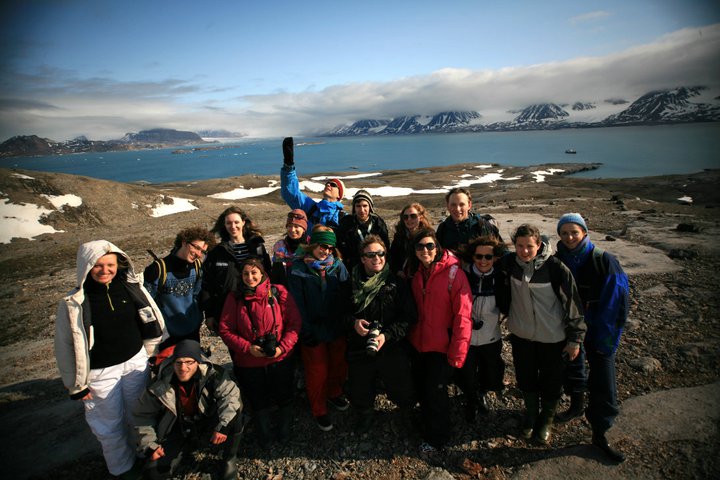This is a guest post written by Samuel Lee-Gammage with photos by Marina Flevotomas and Luka Tomac. They participated in the Arctic Climate Training in June 2011. Organized by the British Council and Youth In Action, 17 young people from 12 different countries came together in Svalbard to learn both from each other and expert trainers from UNEP’s Polar Centre, GRID- Arendal.
 In common consciousness the Arctic is a place of myths, legends and folk law, where night and day become blurred, and where rippling luminescence flitters across the night sky. It exists but is far away: seen always through a literary or artistic lens, glazed with a smattering of facts gleaned from the media and nature TV programs. Looked at on an average everyday map, it’s a thin strip of water on the top of our earth, but looked at from above it’s an ocean larger than the USA and as deep as the European Alps – fringed by a population containing some 40 distinct indigenous cultures. More than anything else, we as a group have come away from the Arctic with a new perspective on our world and the problems it faces, the ‘Arctic Perspective’.
In common consciousness the Arctic is a place of myths, legends and folk law, where night and day become blurred, and where rippling luminescence flitters across the night sky. It exists but is far away: seen always through a literary or artistic lens, glazed with a smattering of facts gleaned from the media and nature TV programs. Looked at on an average everyday map, it’s a thin strip of water on the top of our earth, but looked at from above it’s an ocean larger than the USA and as deep as the European Alps – fringed by a population containing some 40 distinct indigenous cultures. More than anything else, we as a group have come away from the Arctic with a new perspective on our world and the problems it faces, the ‘Arctic Perspective’.
It would be easy to think of the Arctic as isolated, as ‘away’, peripheral to our lives in the more clement regions of the world, but in this respect we would be mistaken. The Arctic sea ice, ocean currents and tundra play a vital role in global climate regulation, and it’s still largely intact though-fragile habitats, represent one of the world’s last true wildernesses. It is a place where some of the most productive oceans support ecosystems we are only today beginning to understand, and which connect directly to those of the entire world. Already migratory birds will be scattering across the world to their winter stopovers. Arctic turns and several types of whales will have embarked on their epic annual migrations southward, some perhaps stopping off on Africa’s southern tip before moving on to Antarctica. As their focus turns southwards so too does ours.
Svalbart lies deep within the Arctic Circle at 78 degrees north, almost as far as it is possible to be from Durban by land (over 7000 miles). The vast distance between the two locations belies the truth that they share an urgent connection. That connection is climate change, whose impacts to date in the Arctic are well documented and whose future impacts depend to no small extent on progress being made at COP17 in Durban this November.
As young people and as activists energised and inspired by our experience and our learning, we will be doing what we can to keep the Arctic’s perspective in plain view. Already across Europe and Canada we have been communicating our experience through various action plans and projects in which we continue to advocate for the Arctic’s rich and vulnerable environment, wildlife and people. More than anything we realise that actions have consequences, actions matter, and that it’s easy to forget the impacts that are far away and out of sight. Climate change poses huge challenges for the world and especially the Arctic and we cannot look at these problems without searching for solutions.